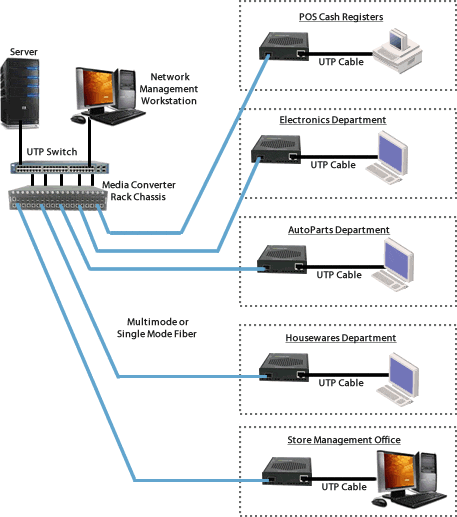Fiber to Ethernet can support large-scale retail networks
To support the equipment, workstations and security technology that goes into a large network of point of sale devices, major retail organizations need to establish extensive networks.
Many have begun turning to fiber to Ethernet technology to help create a high-performance network within an affordable price range.
The networking needs of large retailers are somewhat unique, but can be addressed using fiber to Ethernet technology. The network needs to support devices throughout the store, and, in an effort to keep costs low, must use copper UTP cables. However, optical cables are also necessary to handle long distances. This combination makes fiber to Ethernet technology an ideal solution for the retail sector.
This system offers a number of benefits that perfectly match the needs of a large retailer. The first is providing inexpensive network infrastructure. Since the bulk of the network is built on copper cabling, most of the infrastructure only requires standard Ethernet equipment instead of expensive fiber optic hardware.
A more subtle benefit comes because this network is entirely wired. Since the network infrastructure does not require wireless equipment, which often needs to be housed in the building's rafters or other visible places, the store can avoid becoming cluttered with superfluous network equipment and instead depends on easily-hidden wired architecture. This keeps display spaces free from a mess of wires and keeps the store as attractive as possible.
The operational benefit of these networks is also critical. The fiber to Ethernet establishment lets companies connect point-of-sale devices, departments, management offices and order desks. This makes communication and collaboration easier and provides an important link in a building large enough to make other systems inadequate.

Establishing fiber to Ethernet infrastructure requires businesses to begin with a single server that connects to a copper-based Ethernet switch in the primary computer room. This switch is then connected to a network management controller to oversee all functions. A media converter chassis is also connected to the switch, allowing the Etherent network to include optical cable where necessary. Each network end point, such as a point-of-sale device, also has a media converter to switch the UTP Ethernet signal to optical signal and send it back to the computer room.
The Ethernet-fiber converter is able to use a copper transceiver to transform UTP and RJ45 Ethernet links to a format that can be processed by a fiber optic transceiver. This creates a consolidated, rack-mounted infrastructure capable of gathering diverse fiber links into a single platform.
The ability to provide cost-efficient, high-performance and consolidated infrastructure makes fiber to Ethernet architecture an ideal choice for large retail deployments.